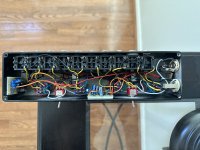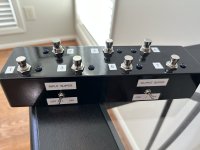mkstewartesq
Well-known member
So, thanks to my pedal building addiction (of which you are all enablers), I had built so many pedals that I had filled up my current 10-loop switcher and had resorted to retiring about five pedals and then daisychaining certain others so that more than one pedal could use a single loop. This is 100% a “me” thing but it hurts my heart to see something I’ve built sitting on a shelf and I’m far too lazy to swap pedals out on the board frequently.
So I decided to move all of my dirt pedals (both those currently active on the board and some that have been retired to my shelf) onto a separate smaller pedalboard and run those off of a single loop on my main switcher (I really don’t ever stack dirt pedals so only one would be active at any given time ). This required an additional switcher and, because I am cheap, I didn’t want to buy a second one. So I found several different plans online for switchers from 2 to 4 loops, selected the best one (some of the plans out there are reported as not working or having issues) and decided to build it with seven loops so that I would have room to grow. No master bypass because that function will be accomplished on the main loop switcher.
There were some minor glitches. Because this switcher and its board will be sitting in a corner, I put the input and output on the same end; that feature, along with the fact that I was having a couple more loops than most diagrams contemplated and was staggering things into two rows made things a bit of a brain teaser to ensure that I didn’t wire up something backwards or out of order. But it’s complete, all of the loops work, and now I’m on to the next circle of hell which is cutting and soldering 14 patch cables to feed this loop switcher.
Thanks for looking.
Mike
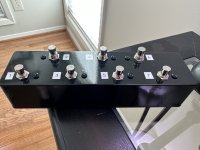
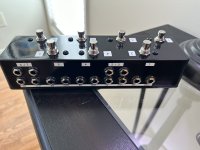
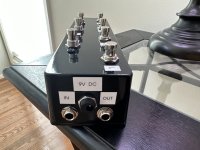
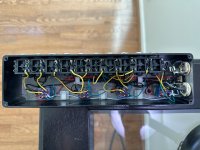
So I decided to move all of my dirt pedals (both those currently active on the board and some that have been retired to my shelf) onto a separate smaller pedalboard and run those off of a single loop on my main switcher (I really don’t ever stack dirt pedals so only one would be active at any given time ). This required an additional switcher and, because I am cheap, I didn’t want to buy a second one. So I found several different plans online for switchers from 2 to 4 loops, selected the best one (some of the plans out there are reported as not working or having issues) and decided to build it with seven loops so that I would have room to grow. No master bypass because that function will be accomplished on the main loop switcher.
There were some minor glitches. Because this switcher and its board will be sitting in a corner, I put the input and output on the same end; that feature, along with the fact that I was having a couple more loops than most diagrams contemplated and was staggering things into two rows made things a bit of a brain teaser to ensure that I didn’t wire up something backwards or out of order. But it’s complete, all of the loops work, and now I’m on to the next circle of hell which is cutting and soldering 14 patch cables to feed this loop switcher.
Thanks for looking.
Mike






